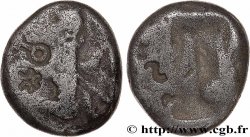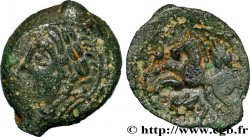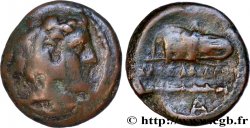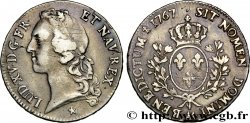v60_0006 - PERSIA - REGNO ACHEMENIDO Darique d'or
MONNAIES 60 (2013)
起拍价 : 1 900.00 €
估价 : 3 200.00 €
竞价记录 : 2 350.00 €
出价数量 : 2
最高出价 : 5 160.00 €
起拍价 : 1 900.00 €
估价 : 3 200.00 €
竞价记录 : 2 350.00 €
出价数量 : 2
最高出价 : 5 160.00 €
种类 Darique d'or
日期: c. 465-425 AC
铸币厂名称/城市 Lydie, Sardes ?
材质 gold
纯度、成色(用角密度) 970 ‰
直径 17 mm
重量 8,34 g.
稀少度 R1
关于品相的说明
Exemplaire sur un flan ovale, parfaitement centré au droit de style encore archaïsant avec la tête bien venue à la frappe. Minuscule petite paille de métal au niveau de l’aine. Jolie patine de collection ancienne
出版目录中的项代码 :
家谱
Cet exemplaire provient de la vente Poindessault du 28 juin 2002, n° 87 et de la collection D. R.
正面
正面的文字 ANÉPIGRAPHE.
正面的说明书 Archer barbu (Le Grand Roi) à demi agenouillé courant à droite, couronné (cidaris), tenant une lance de la main droite et un arc de la gauche ; un carquois rempli de flèches sur l’épaule ; ligne d’exergue.
背面
背面的说明书 Carré creux informe.
评论
Ce type de darique est souvent usé et a circulé pendant plus d’un siècle. C’est le premier multiple en or frappé en quantité très importante. Au revers, le carré creux pourrait prendre la forme d’un animal (tête de lion à droite, la gueule ouverte, cf. E. Babelon, Perses Achéménides, pl. I, n° 10 pour un sicle). Ce type est souvent attribué à Darius Ier (521-486 avant J.-C.) ou à Xerxès (486-465 avant J.-C.). Pour cet exemplaire, une attribution à Artaxerxès II (465-425 avant J.-C.) est probable.
This type of daric is often worn and circulated for over a century. It is the first gold multiple struck in very large quantities. On the reverse, the hollow square could take the form of an animal (lion's head to the right, mouth open, cf. E. Babelon, Perses Achéménides, pl. I, n° 10 for a shekel). This type is often attributed to Darius I (521-486 BC) or Xerxes (486-465 BC). For this example, an attribution to Artaxerxes II (465-425 BC) is likely
This type of daric is often worn and circulated for over a century. It is the first gold multiple struck in very large quantities. On the reverse, the hollow square could take the form of an animal (lion's head to the right, mouth open, cf. E. Babelon, Perses Achéménides, pl. I, n° 10 for a shekel). This type is often attributed to Darius I (521-486 BC) or Xerxes (486-465 BC). For this example, an attribution to Artaxerxes II (465-425 BC) is likely








 对产品描述纠错
对产品描述纠错 打印
打印 分享我的选择
分享我的选择 提问
提问 Consign / sell
Consign / sell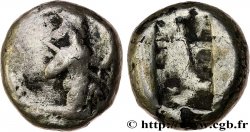
 产品介绍
产品介绍